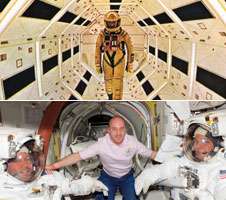1968 Science Fiction is Today’s Reality

The futuristic epic 2001: A Space Odyssey influenced many to fall in love with the limitless possibilities of space exploration. The movie sparked imaginations and provided a realistic preview of what our future in space might look like.
When 2001: A Space Odyssey premiered 40 years ago, living and working in space full time was science fiction. Today, three resident crew members are aboard the International Space Station 365 days a year operating one of the most complex engineering projects in history. The station is helping us push the boundaries of 21st century science, technology and engineering.
From the orbiting complex, NASA astronaut Garrett Reisman recorded a message that was played during the 40th anniversary screening of film on April 25 at the Academy of Motion Picture Arts and Sciences' Samuel Goldwyn Theater in Beverly Hills, Calif.
Actor Tom Hanks gave an introduction at the special event. Following the screening, actors Keir Dullea, Gary Lockwood and Daniel Richter, Oscar®-nominated visual effects wizard Douglas Trumbull and special effects artist Bruce Logan discussed their work on the film.
The Smithsonian Folk Life Festival will have a public screening of 2001: A Space Odyssey at the Baird Auditorium at the Museum of Natural History, Washington, on Sunday, June 29, at 5 p.m. EDT.
The film was a creative collaboration by director Stanley Kubrick and science fiction author Arthur C. Clarke. The two men embarked on a creative collaboration: a novel and a screenplay inspired by Clarke's 1950 short story "The Sentinel."
2001: A Space Odyssey shows an imagined version of our future in space, some of which has come to pass:
-- One of the most notable visions is the large, low Earth orbiting, revolving space station in the film. Although the shape is different, today's space station is permanently crewed and international.
-- Flat-screen computer monitors that were unheard of in 1968 are now commonly used on the space station.
-- The film imagines glass cockpits in spacecraft, which are now present on the flight deck of the space shuttle.
-- The film also envisions in-flight entertainment in space. Today there are DVDs, iPods and computers with e-mail access.
-- Another famous scene from the movie depicts an astronaut jogging in space. Aboard the International Space Station, exercise in space is routine. In April 2007, 210 miles above Earth, astronaut Sunita Williams ran the Boston Marathon while in orbit.
Although some of the things in the film are not yet realities, some of them are in the works. For example, although we haven't yet colonized the moon, NASA has a plan in place to return to the moon by 2020 and maintain a presence there. Other ventures in space, such as hotels in orbit and routine tourist space travel are being planned by commercial spaceflight companies.
Along with the 40th anniversary of 2001: A Space Odyssey, this year also marks the 50th anniversary of NASA.
As we finish constructing the station, we're working to return to the moon and then journey to Mars and beyond. We are part of the wonderful future that visionaries such as Arthur C. Clarke and Stanley Kubrick imagined 40 years ago.
Source: NASA





















